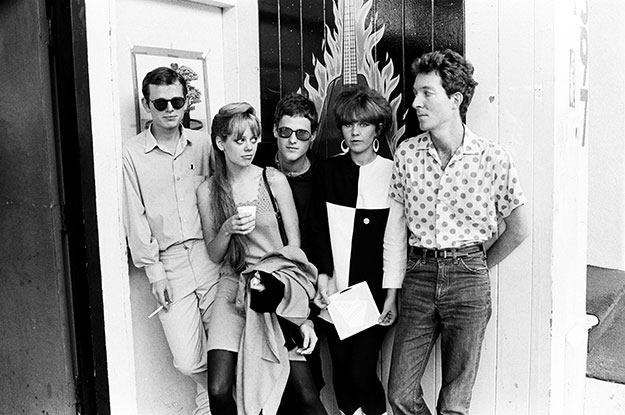Welcome to Three Easy Pieces, where I examine a witheringly small alley of pop culture, from how it started to how it looks today. This time: art-rock in the mainstream. I love when art-rock bands -- those noted adversaries to pop music who lurk in the underground -- take the limelight for an international audience. How do they react? Does their music become compromised, or do they shuffle through and radicalize a whole new audience to be open to more daring music? Now, according to the laws of the column I created, I should probably kick things off with the Beatles, Brian Wilson, or maybe David Bowie. Well, tough. It's my column to break, and I've fallen down a B-52s rabbit hole recently, so guess where we're starting!
Honorable mention: Talking Heads, Peter Gabriel, Devo
More than any other popular band I can think of, the B-52s feel the most like a group that could've organically grown out of the Tacoma music scene of my teens. Their origin story -- a gaggle of scenesters start jamming together after getting wasted at a Chinese restaurant -- is nearly identical to so many never-to-be bands that my friends and I have formed, over the years. The B-52s started out with the kind of confidence that would lead them to release the admirably strange (and incredibly long!) "Rock Lobster" as their first single, which makes their later status as multi-platinum-selling artists all the more enchanting. They were also wonderfully queer, bridging the gap for LGBTQ representation on radio.
Their biggest success came with 1989's "Love Shack," nine years after John Lennon declared them his favorite band. Some may argue that "Love Shack" showing up on so many karaoke stages might invalidate the B-52s from discussion of art-rock bands going big time, but those people need to carefully listen to the song again. No, it's not a noodling, King Crimson head-trip, but it's full of the profound weirdness that defined the B-52s: the nods to trashy music and films of the ‘50s and the ‘60s surf influences may be softened, but every bit of the oddities that Kate Pierson, Cindy Wilson, Fred Schneider and company possess, is brought to the table. Plus, you get to learn about all 16 dances!
DEVELOPMENT: Gorillaz
Honorable mention: Björk, Beck, Kate Bush, The Flaming Lips, Radiohead
The notion of creating a fake pop band of cartoon characters was not a novel idea when Gorillaz formed in 1998 -- the Archies beat them to it by 30 years -- but Gorillaz had more ambitious endeavors on their mind than turning the Riverdale gang into teen idols. Created by artist Jamie Hewlett and Blur's Damon Albarn, Gorillaz' four animated avatars obscured the fact that the "band" was actually made up of Albarn being joined by a who's who of guest musicians and performers, including just about everyone from the world of ‘80s and ‘90s hip-hop, and rock icons like Lou Reed, Mick Jones and Paul Simonon.
Musically, Gorillaz have always been thrillingly unpredictable, incorporating elements of math-rock, trip-hop, electronica, psychedelia, symphonic rock, and funk, always with a strong footing in hip-hop. Beyond the central conceit of the "virtual band," Gorillaz pushed the envelope with concept albums like Plastic Beach and The Fall. Though there were always plans to make a feature length Gorillaz musical movie, the project never came to fruition. Seeing any of their visually dynamic live shows will make you long for the big screen Gorillaz treatment.
TODAY: Arcade Fire
Honorable mention: St. Vincent, Animal Collective, Modest Mouse
When Arcade Fire won the Grammy for Album of the Year in 2011, they were met with a chorus of out-of-touch voices snidely saying, "Who?" For those who'd been paying attention, Arcade Fire's win for The Suburbs, while gratifying and a little surprising, did not come from out of nowhere; the band had spent the better part of a decade making names for themselves as purveyors of wild, cathartic, willfully esoteric, orchestral rock that eschewed irony in favor of raw emotion. After the gorgeous and vital Funeral was released in 2004, the band got the nod of approval from art-rock titans like David Bowie and David Byrne. In the intervening years, Arcade Fire have made efforts to let their sound evolve with the times -- not always successfully -- pinging around from the tactile bombast of their early days, to world music, prog-rock dalliances, mutated Americana, and extraterrestrial disco, always searching for that rich feeling of discovery.
Three Easy Pieces will return, next month, with: Comedy Podcasts.





Read Comments